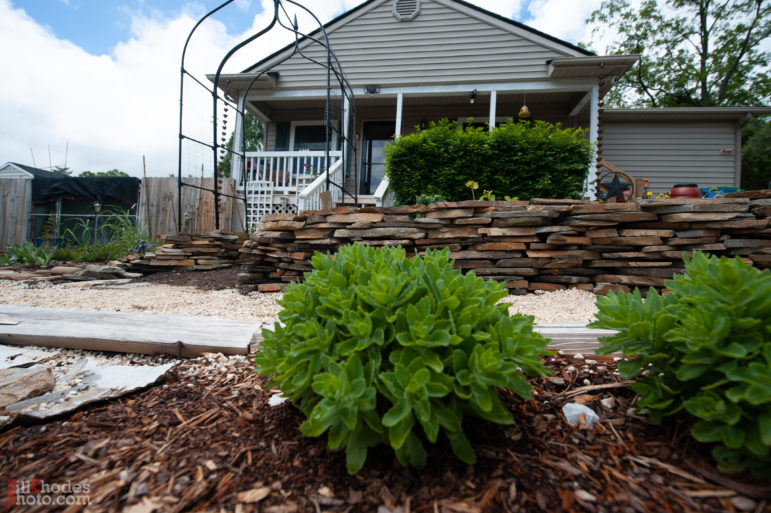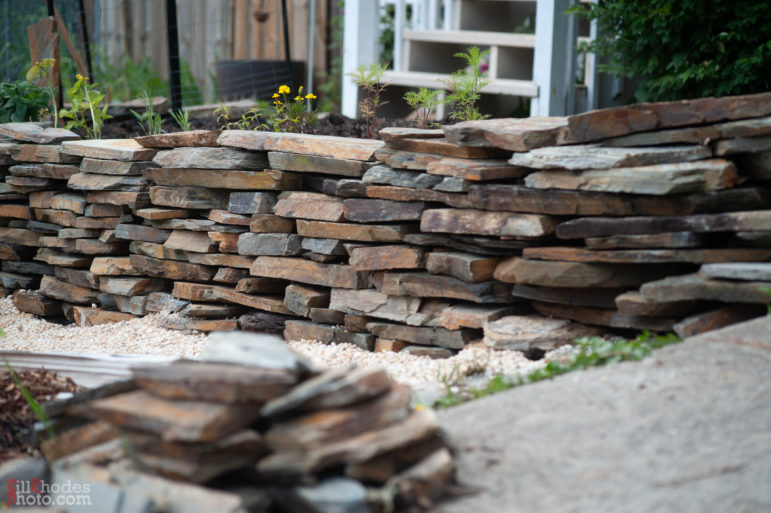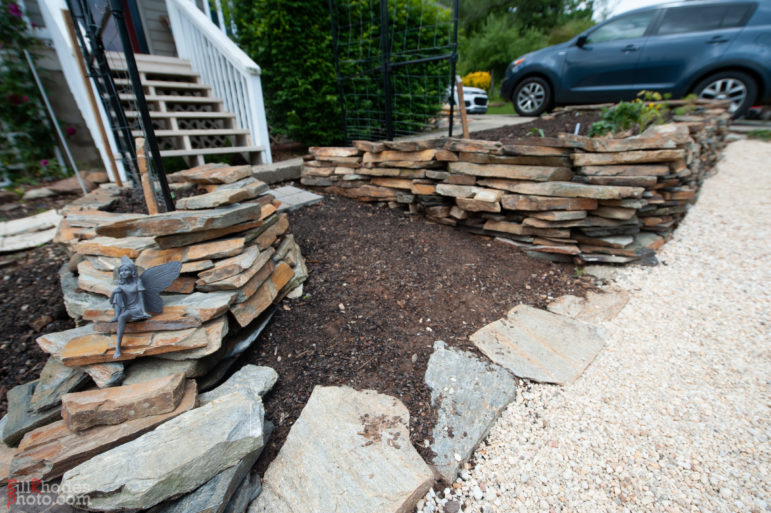
In all my dreams of someday owning a little cottage with gardens and fruit trees, I pictured an old stone wall around a flower-filled garden. I am sure I saw such a wall in some old black-and-white film I watched when I was a child, and no doubt such walls made subtle appearances in the countless British detective shows I have watched since. I certainly read descriptions of them in any number of books, and the upstate New York countryside that was for so long my home is dotted with them.
A stone wall symbolizes steadiness and stability, security and comfort, and carries an ethereal timelessness belied by the weight of its presence. I discovered the work of Robert Frost before I even hit the double digits of age, and thanks to his poem, “Mending Wall,” I have seen the mystery and magic in stone walls as well. For nearly my entire life I have carried that poem in my heart, knowing it to hold a truth not just about human relationships, but about the relationships that humans have with the land and land spirits around them.
‘…Before I built a wall I’d ask to know
What I was walling in or walling out,
And to whom I was like to give offense.
Something there is that doesn’t love a wall,
That wants it down.’ I could say ‘Elves’ to him,
But it’s not elves exactly, and I’d rather
He said it for himself.
When I first saw the property that has since become Bear Path Cottage, I immediately knew where the stone wall should go. I also knew that the wall, like the gardens, needed to wait until I had time to get to know the land, to know the way the sun and rain fall upon the space, to know the critters that pass through or call it home, and the land spirits that dwell here. I wanted to be sure that the wall would not give offense to any being.

Bear Path Cottage [courtesy Bill Rhodes Photo]
After a little more than a year of observation and interaction had passed, early this spring I began laying out the line for the first course of stones for the wall. As with most of my yard work, this was up close and personal business, done while I was sitting on the ground. I used a trowel for any digging that needed to be done to make a level line. As I worked, I talked to the cottage and to the land spirits, and I listened to what they had to tell me. I watched the insects that crawled and flew around, saw half a dozen different kinds of bees and wasps flying about, and found dozens of grubs and worms buried in the rich river bottom earth. The birds that hang out in that section of the yard became nonplussed by my presence, and frequently visited while I worked, offering songs and stories that brightened my days.
Because I was working on other projects at the same time, and because weather and health sometimes interfered with being outdoors, it took nearly three weeks to finish setting in the first course. Those three weeks gave me extra time to focus on my communications with the cottage and her spirits, and in that time I became certain that they would welcome the wall. The cottage has frequently shown and told me that she is eager to grow and nurture plants, critters, and people. I felt that energy from her the first time I walked around the property, and it is the constant underlying rhythm to her every mood. The intention for the wall is not to keep anything in or out; it is to help add beauty to the property and to help pollinators by gaining planting space for flowers and herbs. These are goals the cottage and I share.
Three weeks after I started the coarse work, and 360 days after we took possession of the cottage, two pallets of Mountain Mist stone were delivered to the top of the cottage driveway. I admit to being momentarily intimidated by the scope of the project I was undertaking when I looked at those piles of rock, but I sat down in the grass under the loblolly pine to contemplate the space in which I would be working. I stilled my thoughts to do a calming meditation in which I envisioned myself moving all of those stones. I felt the humor rise within me and from the cottage when I realized I did not need to be intimidated – I was simply going to be placing one stone at a time. Nothing more, and nothing less. Just one stone.

The stone wall outside of Bear Path Cottage [courtesy Bill Rhodes Photo]
Five days later and one year to the day of taking possession of the cottage, I set to work in earnest to complete the stone wall project. On that day, while digging out the last bit of the base layer, I discovered a large, soft, limestone rock. At first I thought I might be able to move it, but there was no way to measure the size of the rock, so after some consideration I simply incorporated it into the foundation of the north-east corner of the wall.
I was especially interested in that limestone rock because it sits not a hundred feet from a humongous and solid rock that is the anchor for the northwest corner of the cottage proper, and is of a type completely different from the limestone. That rock crests the surface of the yard near the border, and I tried to plant a hawthorn tree near that location. It took me five tries to find a spot where I could dig a hole that did not run into the underground body of the rock.
I was contemplating this “Lesson of the Two Rocks” – get to know the rocks on your land just as you know the trees and plants, because foundations matter – while I was pulling stones from one of the pallets. I had decided that in order to save labor I was going to use stones in the order they came off the pile, and I had a rock that should have gone into the second course under the arches. That would have put it under the ground, never to be seen again. It did not fit quite right so I turned it over to try another angle and saw a most beautiful and unique pattern of coloration. It was so pretty I just could not hide it away and decided to save it for use on the top course. Later that evening something prompted me to show the rock to my father-in-law, who had majored in geology in college. He pointed out that the discoloration I thought was just an unusual marking was actually a fossil, probably from the Devonian period. Mountain Mist is quarried from this region, and I am delighted and honored to bring this piece of history home to the cottage and love it for the gift that it is.

The stone wall near the steps of Bear Path Cottage [courtesy Bill Rhodes Photo]
Laying out a wall seems like it should be easy work; one just sets one stone on top of another, and another, and another. But this was a constant learning process, moving and turning stones so they fit just so, working every piece in a way that gently sloped the wall in toward the garden it framed. My research and Mr. Frost had made it clear that a stone wall is, inevitably, going to fall. The trick is to build it in such a way that when it does fall, it leans into retained earth rather than away from it.
I talked this theory out loud with the cottage one day while I was struggling to settle a particularly challenging couple of pieces. I moved to stand up and my hand slipped, and I fell a bit against the wall. I expected those pieces to go flying, but they did not. The wall held, and I clearly heard the message from the cottage. She will support the work I do here.
25 days after I began steadily working on it, I completed the stone wall. Not until the final work was almost done did I research the actual weight of the stone and learned that each pallet weighed 2,000 pounds. By building the stone wall I added 4,000 pounds of strength and structure to the cottage gardens, plus 5 cubic yards of good soil.
I did not think the wall would be solid enough to sit on, but it is. It feels comfortable and natural to do so, as if the wall has always been here and as if I have always done so. The stone wall is part of the cottage now, and I trust her to hold me because everything I do here is, ultimately, about my relationship with my land and the land spirits.
The Wild Hunt always welcomes submissions for our weekend section. Please send queries or completed pieces to eric@wildhunt.org.
The views and opinions expressed by our diverse panel of columnists and guest writers represent the many diverging perspectives held within the global Pagan, Heathen, and polytheist communities, but do not necessarily reflect the views of The Wild Hunt Inc. or its management.
The Wild Hunt is not responsible for links to external content.
To join a conversation on this post:
Visit our The Wild Hunt subreddit! Point your favorite browser to https://www.reddit.com/r/The_Wild_Hunt_News/, then click “JOIN”. Make sure to click the bell, too, to be notified of new articles posted to our subreddit.
